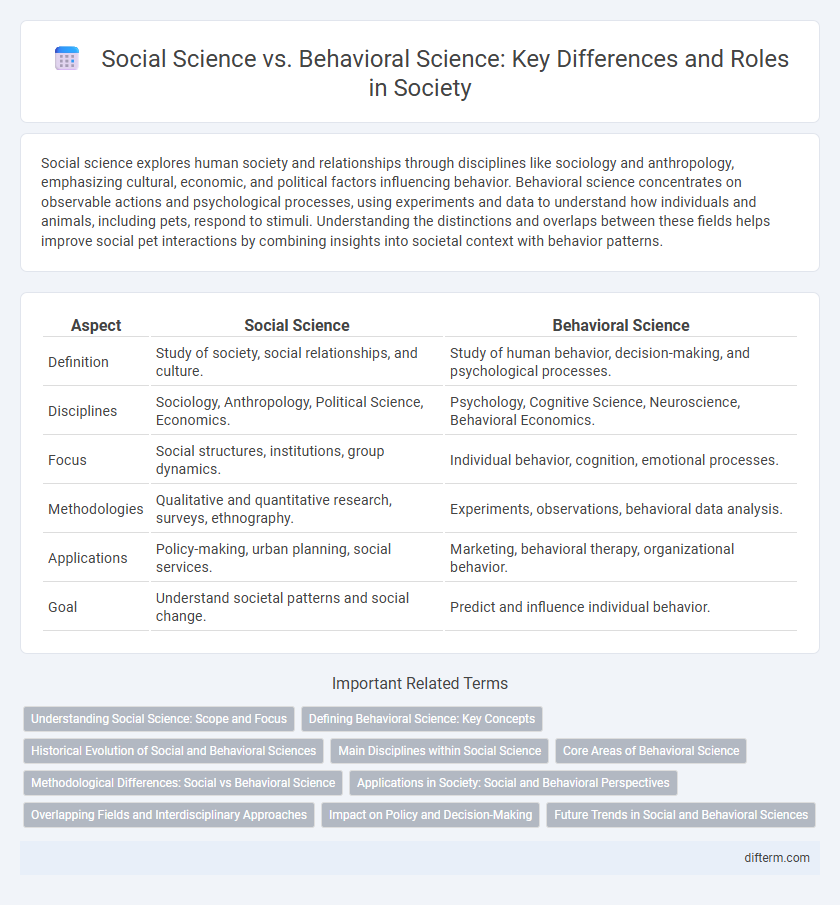Social science explores human society and relationships through disciplines like sociology and anthropology, emphasizing cultural, economic, and political factors influencing behavior. Behavioral science concentrates on observable actions and psychological processes, using experiments and data to understand how individuals and animals, including pets, respond to stimuli. Understanding the distinctions and overlaps between these fields helps improve social pet interactions by combining insights into societal context with behavior patterns.
Table of Comparison
| Aspect | Social Science | Behavioral Science |
|---|---|---|
| Definition | Study of society, social relationships, and culture. | Study of human behavior, decision-making, and psychological processes. |
| Disciplines | Sociology, Anthropology, Political Science, Economics. | Psychology, Cognitive Science, Neuroscience, Behavioral Economics. |
| Focus | Social structures, institutions, group dynamics. | Individual behavior, cognition, emotional processes. |
| Methodologies | Qualitative and quantitative research, surveys, ethnography. | Experiments, observations, behavioral data analysis. |
| Applications | Policy-making, urban planning, social services. | Marketing, behavioral therapy, organizational behavior. |
| Goal | Understand societal patterns and social change. | Predict and influence individual behavior. |
Understanding Social Science: Scope and Focus
Social science encompasses a broad range of disciplines such as sociology, anthropology, and political science, focusing on the study of human societies, cultures, and social relationships. Behavioral science specifically investigates human behavior through psychology, cognitive science, and neuroscience, emphasizing individual and group decision-making processes. Understanding the scope of social science highlights its interdisciplinary nature and its commitment to analyzing complex social phenomena broadly beyond individual behavior.
Defining Behavioral Science: Key Concepts
Behavioral science explores the systematic study of human actions, emphasizing psychological, cognitive, and emotional factors that influence behavior. It integrates disciplines such as psychology, neuroscience, and behavioral economics to analyze decision-making processes and habit formation. Core concepts include reinforcement, motivation, and social influence, which help predict and modify behavior patterns in diverse social contexts.
Historical Evolution of Social and Behavioral Sciences
The historical evolution of social sciences traces back to ancient civilizations where philosophy and early sociology emerged to study human societies and cultures. Behavioral science developed later, particularly in the 20th century, emphasizing empirical research on individual and group behaviors through psychology and anthropology. The distinction grew as social science focused on societal structures and institutions, while behavioral science concentrated on cognitive and emotional processes influencing human actions.
Main Disciplines within Social Science
Social science encompasses main disciplines such as sociology, anthropology, political science, and economics, each exploring human society and social relationships from macro to micro perspectives. Behavioral science primarily focuses on psychology, cognitive science, and behavioral economics, analyzing individual and group behavior through experimental and observational methods. These disciplines together provide a comprehensive understanding of social dynamics, decision-making processes, and cultural influences shaping human interactions.
Core Areas of Behavioral Science
Behavioral science centers on understanding human actions through core areas like psychology, cognitive science, and neuroscience, which analyze mental processes, decision-making, and behavioral patterns. Social science broadens the scope by incorporating anthropology, sociology, and political science to examine societal structures, cultural dynamics, and group behaviors. Emphasizing interdisciplinary methods, behavioral science applies experimental research and data analysis to predict and influence individual behavior within social contexts.
Methodological Differences: Social vs Behavioral Science
Social science employs qualitative methods such as ethnography, case studies, and archival research to explore complex societal structures and cultural contexts. Behavioral science prioritizes experimental and quantitative techniques like controlled laboratory experiments and statistical analysis to investigate individual and group behavior. These methodological distinctions reflect the broader aims of social science to understand societal dynamics and behavioral science to predict behavioral outcomes.
Applications in Society: Social and Behavioral Perspectives
Social science investigates societal structures, culture, and human interactions to address community issues, while behavioral science analyzes individual and group behavior using psychological principles to influence decision-making. Applications in society include policy development, public health campaigns, and education reform, leveraging insights from both fields to improve social welfare and promote behavior change. Integrating social and behavioral perspectives enhances programs targeting poverty reduction, mental health, and community resilience.
Overlapping Fields and Interdisciplinary Approaches
Social science and behavioral science both study human actions, with social science focusing on societal structures and behavioral science emphasizing individual behavior patterns. Overlapping fields include psychology, sociology, anthropology, and economics, which collectively analyze how social environments influence behavior. Interdisciplinary approaches integrate methods from these domains to address complex issues like public health, education, and social policy, enhancing the understanding of human interactions within societies.
Impact on Policy and Decision-Making
Social science provides a broad understanding of societal structures, cultural norms, and economic systems, influencing policy-making through comprehensive analyses of human interactions and institutional frameworks. Behavioral science offers insights into individual and group behaviors, enhancing decision-making processes by predicting responses to policies and interventions based on psychological and cognitive mechanisms. Policymakers utilize social science to design inclusive frameworks while relying on behavioral science to implement effective strategies that drive behavioral change and improve policy outcomes.
Future Trends in Social and Behavioral Sciences
Future trends in social and behavioral sciences emphasize the integration of big data analytics and artificial intelligence to enhance predictive modeling of human behavior. Interdisciplinary research leveraging neuroscience, psychology, and sociology aims to develop personalized interventions for social issues such as mental health and inequality. Increased focus on ethical considerations and digital behavior will shape policy-making and societal impact assessment.
social science vs behavioral science Infographic

 difterm.com
difterm.com